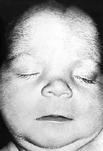Fetal alcohol syndrome epidemic on Manitoba reserve
David SquareCMAJ 1997;157:59-60
[ en bref ]
David Square is a freelance writer living in Tyndall, Man.© 1997 David Square
In briefFetal alcohol syndrome/alcohol effects (FAS/FAE) has reached epidemic proportions on a First Nations Reserve in Manitoba, researchers have concluded. Their study was launched after teachers complained that half the children on the reserve were incapable of learning. Although the study focused on aboriginal children, an American observer says white, middle-class, educated women are also at risk, and the problem is underidentified within that population. An advertising campaign funded by the Manitoba Medical Association helped increase public awareness of this "entirely preventable" problem, but researchers say more studies, intervention and programs are needed.
En brefDes chercheurs ont conclu que le syndrome d'alcoolisme ftal et les effets de l'alcool sur le ftus (SAF/EAF) ont atteint des proportions épidémiques dans une réserve des premières nations du Manitoba. L'étude a été lancée après que des enseignants se soient plaints que la moitié des enfants de la réserve étaient incapables d'apprendre. Même si l'étude a porté avant tout sur des enfants autochtones, un observateur américain affirme que les femmes blanches éduquées de la classe moyenne sont aussi en danger et que le problème n'est pas assez défini dans cette population. Une campagne de publicité financée par l'Association médicale du Manitoba a aidé à sensibiliser davantage la population à ce problème «entièrement évitable», mais les chercheurs affirment que d'autres études, interventions et programmes s'imposent.
A recent study conducted on a First Nations Reserve in Manitoba indicates that 1 in 10 children is the victim of alcohol teratogenesis. And that, says a researcher involved in a seminal investigation of fetal alcohol syndrome (FAS) and possible fetal alcohol effects (FAE) in Canada's aboriginal population, is just the tip of the iceberg,Dr. Albert Chudley, a geneticist at the University of Manitoba, said that for every child identified with FAS/FAE at an Ojibwa school in northern Manitoba, there are probably 2 or 3 others with behavioural and learning problems caused by exposure to alcohol in utero. Chudley and Dr. Michael Moffatt, a pediatrician and head of Community Health Sciences at the University of Manitoba, were invited by band elders to conduct their study after teachers complained that half the reserve's children were incapable of learning.
Their findings suggest that FAS/FAE is epidemic on at least 1 reserve in Manitoba and the situation might be similar at others. "The world frequency of fetal alcohol syndrome in live births is 1 to 3 cases in 1000, according to a 1990 study by the National Institute on Alcohol Abuse and Alcoholism in the US," Moffatt said. "We're talking roughly 100 cases of FAS/FAE [per 1000 births] on the reserve, and that qualifies as an epidemic in my book."
Chudley and Moffatt received permission to comb through the medical records of 179 families and to examine the children for discriminating features related to FAS/FAE, such as short palpebral fissures, flat midface, short nose, indistinct philtrum and thin upper lip. "The medical records indicated that about 40% of the children, who ranged in age from 5 to 15 years old, had been exposed to alcohol in utero," Chudley said.
The researchers identified 11 children as having FAS and an additional 6 with FAE. Moffatt said the FAS children exhibited many of the central nervous system dysfunctions associated with alcohol teratogenesis, including learning or attention problems, hyperactivity, microcephaly, seizures and below-average scores for intelligence.




Adolescent girl diagnosed with FAS at birth with later intellectual functioning in the borderline range. Photographed at birth, 9 months, 5 and 14 years of age. While gradual maturation of facial features is taking place, note persisting small palpebral fissures, relatively long, smooth philtrum and narrow upper vermilion. (From Streissguth AP, Aase JM, Clarren SK et al. Fetal alcohol syndrome in adolescents and adults. JAMA 1991;265:1961-7; published with permission.)Moffatt said that until now it has not been acceptable to talk openly about FAS/FAE, but now it is time for federal and provincial governments to take action. In Manitoba, many addiction treatment centres have been closed or cut back in size at a time when more money is needed for education and prevention. "FAS/FAE is entirely preventable," Moffatt said, "but many mothers are still unaware of the harm that can be done to a fetus when alcohol is consumed during pregnancy."
Moffatt cites an advertising campaign undertaken in Manitoba as a good example of what can be done to enlighten the public. Initiated by Dr. Oscar Casiro, director of the Newborn Follow-up Program in Winnipeg, and funded by the Manitoba Medical Association, the public-awareness campaign was designed to reach a broad female audience.
A 30-second message on alcohol and pregnancy was broadcast over a 10-week period by 5 Manitoba television stations. Appearing daily in English, French and Cree, the advertisement was shown 585 times in prime and non-prime-time slots. In addition, a survey asking questions about general health and alcohol, as well as pregnancy, was mailed to 3000 women aged 15 to 45 before and after the campaign. The results indicated that after the campaign a significantly higher proportion of women thought that drinking alcohol during pregnancy could cause mental, physical and behavioural abnormalities in a baby.
"The success of this campaign indicates that advertising is one way to educate the general public about alcohol and FAS/FAE," said Moffatt. "An ongoing campaign will help to get the message across, but an integrated approach to helping these kids is badly needed."
Moffatt wants each community to be responsible for identifying children with FAS/FAE. "With the proper government-financed programs in place, we could take some steps toward helping these kids."
Former CMA president Dr. Jack Armstrong, a Winnipeg pediatrician and a longtime advocate for improved aboriginal health care, has witnessed the devastating effect of FAS. "I knew a 13-year-old child who was unable to tell the time," said Armstrong, who stressed that FAS is not a problem unique to the aboriginal population.
"The white population cannot point smugly at aboriginals and claim fetal alcohol syndrome is just a native problem. For one thing, we [white Europeans] helped to create the problem by refusing to acknowledge aboriginal culture and by sending Indian children to residential schools. People with low self-esteem often turn to alcohol for consolation."
Moreover, said Armstrong, the incidence of FAS in the white population may well be greater than the 1 to 3 cases per 1000 reported in the 1990 US study. "We whites don't like to discuss our problems with alcohol and tend to sweep them under the rug."
Indeed, a study published in 1990 by the National Council on Alcoholism and Drug Dependence revealed that 16% of the general obstetric population drinks enough during pregnancy to be at risk for producing children with some fetal alcohol effects, according to Diane Malbin.
Malbin, who holds a master's degree in social work, is cofounder of the FAS/Drug Effects Clinical Programs in Portland, Oregon. She has a daughter with FAS who was not diagnosed until age 6 because, in Malbin's words, "I was in denial and my denial was reinforced by physicians who labelled my concerns and questions about my daughter's health 'parental guilt' or 'over-reactive.' "
Malbin said the most dangerous stereotype concerning FAS/FAE is that the populations at risk for giving birth to FAS/FAE children comprise native Americans or blacks who are poor and uneducated and live in the inner city.
In reality, she said, the group most at risk and the most underidentified comprises white, middle-class, educated women. "The stereotype exists in part to meet the need of the dominant culture -- uncomfortable professionals and the general population -- to have a focus for the problem, an identifiable group on whom to focus the considerable anger, frustration and moral indignation generated by this hot topic."
Dr. Ann Streissguth of the University of Washington, considered one of the leading FAS/FAE researchers in the US, feels an up-to-date study on the incidence of the problems in the white population is long overdue.
Meanwhile, Chudley and Moffatt plan to conduct further studies in rural Manitoba and Winnipeg. "The Canadian Centre for Substance Abuse estimates it costs about $1.4 million to care for one FAS child for extra health care, education and social services," said Chudley. "It is clearly in the public interest to learn more about this preventable disease."
Send a letter to the editor responding to this article
Envoyez une lettre à la rédaction au sujet de cet article
| CMAJ July 1, 1997 (vol 157, no 1) / JAMC le 1er juillet 1997 (vol 157, no 1) |